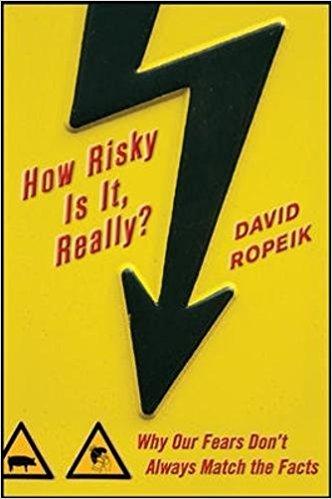How Risky Is It, Really? Summary
5 min read ⌚
 Why Our Fears Don’t Always Match the Facts
Why Our Fears Don’t Always Match the Facts
Are fears real? Do the things we are afraid of, are really that scary?
Most of them are not.
Today, we are presenting you with the most common ways the mind plays with your perceptions and how you can change that.
Who Should Read “How Risky Is It, Really?”? And Why?
In “How Risky Is It, Really?” author David Ropeik focuses on the common situations when people misinterpret a possibly dangerous event, and he teaches you how you can decide the seriousness of risks more accurately.
We recommend this book to readers involved in social policy, risk management, as well as to those who feel the news affect them too much.
About David Ropeik
 David Ropeik is the co-author of RISK and has previously written for several major metropolitan newspapers.
David Ropeik is the co-author of RISK and has previously written for several major metropolitan newspapers.
“How Risky Is It Really? Summary”
We all feel some kind of fear at times.
If someone tells you that there is a risk, you will die if you ride the airplane, you may avoid getting onboard one, even if you may do other statistically riskier things like riding the car each day.
When people try to measure risk, they suffer from their perception gap. This gap means that the possibility of inaccurately evaluating possible harm.
If you want to narrow the perception gap and assess situations more correctly, you need to understand how humans respond to risk.
Just imagine yourself in the middle of a risky situation.
If such a situation happens, you will feel fear even before you can consciously get what is going on. Your reaction to the threats nowadays will be a lot similar to the reactions of our ancestors, when faced with physical threats.
When you feel fear, your body reacts in a certain way. A fast heartbeat, focused vision, and hearing, rapid breaths are just some of the physical cues to fear.
Your body also releases glucose which is supposed to give you enough energy so can react and save yourself from the threat.
Of course, all of these things happen before you can consciously think about them.
In fact, biologically, you first feel fear, and then you think.
What this means is that in some cases fear can muddle rational thinking.
The curious thing about your brain is that it does not matter whether the situation is real or not – even thinking about a danger can trigger a similar response.
Most people believe that the best way to conquer a fear is to get exposed to it as much as you can. However, although they know this, and preach it to others, people rarely use it to cure their fears.
There are two types of fear: built in, and created. Just think about fear of the dark, or people’s unease with scary faces. But there are also more complicated dangers, which people do not notice as quickly – such as the perils that climate change brings.
Some people argue that being rational about risks is the best way to deal with them.
In other words, they believe that collecting a satisfying amount of data and carefully analyzing it will make you realize that your fears are not logical, and thus cure you of them.
However, this is not always the case.
We list the problems of this approach in the key lessons below, and now we will continue listing the factors that influence your perception of risk.
-
- “Trust”: when you feel a lack of trust, you immediately consider a situation more threatening.
-
- “Risk versus benefits”: the truth is, when it comes to most bad things, the likelihood of them happening to you is the same as it is for someone else. However, people put different values on risks based on the benefits they believe they receive.
-
- “Control”: feeling in control can decrease your fear even in the most dangerous situations.
-
- “Choice”: when you select the situations you are in, they do not seem as scary and uncertain.
-
- “Natural or human-made?”: natural products reassure people.
-
- “Pain and suffering”: people fear that peril comes with a lot of pain.
-
- “Uncertainty”: is the opposite of choice and control, which means that when you are unsure of what is going on, you feel more overwhelming danger.
-
- “Catastrophic or chronic”: immediate dangers scare people more than regular ones.
-
- The same goes for “New or familiar?”
-
- “Can it happen to me?”: if you think that something may affect you, you will feel more fear.
-
- “Risks to children”: Children being in danger biologically triggers more fear in people.
-
- “Personification”: risks which are expressed as numbers do not affect you like those to which you add a name, a face, and a story.
- “Fairness.”
Key Lessons from “How Risky Is It, Really?”
1. The Limits of Reason
2. Mental Shortcuts
3. Closing the Gap in Your Perceptions
The Limits of Reason
Using rationalization as an approach has three problems.
First, emotions are faster than thoughts.
Second, the amount of information you get is limited, so you will never have all the data you need to make an entirely certain decision.
Third, even if there is a case in which you have all the information, your mind operates with different shortcuts which undermine your rationalization.
These different types of shortcuts are our second lesson.
Mental Shortcuts
-
- Perceptions based on “biases” and the way information is received.
-
- “Categorization” of events by using stereotypes, which assign meaning from one experience on a whole group.
-
- Previous experiences have a tremendous effect on how readily you notice and respond to threats. If you have some terrible experience previously, similar to the danger that you face in the present, chances are you will notice it immediately, and consider it a personal risk, regardless of its actual nature.
-
- Being too optimistic can alter your judgment as well.
-
- “The endowment effect” makes you value something you own more than something you don’t own.
- You often use “anchoring and adjustment” when numbers and estimations are into play.
Closing the Gap in Your Perceptions
The good news is that it is possible to narrow your perception gap.
Each change starts with acknowledging the current situation you are in. Then, assess both the absolute risk and the relative risk (number and percentage) of a situation.
Reframe your mind and question if everything that media serves to you is right. Question yourself, and do not let your emotions guide every action of yours.
Like this summary? We’d Like to invite you to download our free 12 min app, for more amazing summaries and audiobooks.
“How Risky Is It, Really?” Quotes
Any risk feels bigger if you think it could happen to you. Share on X We have evolved to be afraid of the dark. For most of human history, the dark was a time when we were in the food chain, not at the top of it. Share on X Blaming the news media is a favorite way to explain why many people are convinced that these are the riskiest times humans have ever faced, despite the fact that we live in a safer world than humans have ever lived in. Share on X It is not news when planes don’t crash. Share on X When we get risk wrong, when we are more afraid or less afraid than the facts suggest we need to be, the Perception Gap becomes a risk in and of itself. Share on XOur Critical Review
“How risky is it, really” is a simple book which is easy to understand, with in-depth explanations, which are at times too long. Also, the risk factors the author lists share similarities, but in any case, every reader can easily digest and practice the recommendations from the book. In the end, that is all that counts.
Emir is the Head of Marketing at 12min. In his spare time, he loves to meditate and play soccer.


 Why Our Fears Don’t Always Match the Facts
Why Our Fears Don’t Always Match the Facts




